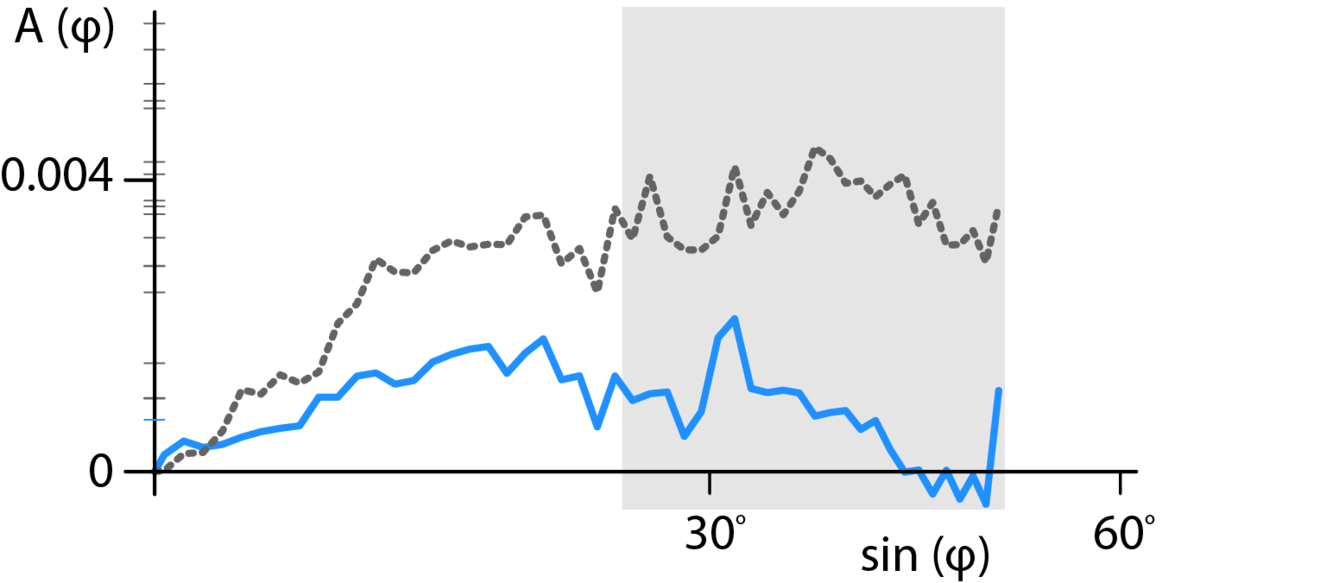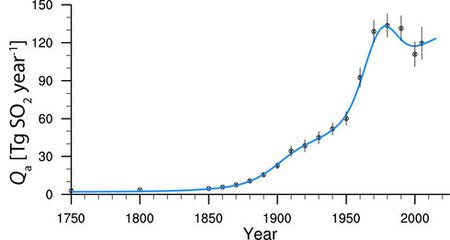New study: Cooling by aerosols weaker and less uncertain
A perturbation to the composition of Earth's atmosphere can be quantified through a perturbation of the radiative balance at the top of the atmosphere ("radiative forcing"). Radiative forcing is a motive force for climate change; for small perturbations Earth's global mean surface temperature is expected to change proportionally with this forcing. Aerosols in the atmosphere contribute to the radiative forcing; if there are more aerosols, they typically reflect more of the incoming solar radiation back to space and thus cool the surface. When, in the early 1990s, this effect first began to be considered quantitatively, it was estimated to have been -2.3 W/m2, which would have largely offset the warming effect of greenhouse gases at that time. Over time, research has pointed toward a lower magnitude of the aerosol forcing, but has had a difficult time ruling out the possibility of a very strong cooling effect from aerosols. For instance, the Fifth Assessment Report (AR5) of the IPCC, of which Bjorn Stevens was a co-author, estimates a forcing of -0.9 W/m2 but retains a large uncertainty (-0.1 W/m2 to -1.9 W/m2). An aerosol forcing as large in magnitude as -1.9 W/m2 would offset a great deal of the forcing from rising concentrations of greenhouse gases and make the net radiative forcing over the instrumental record smaller in magnitude. Given the temperature rise observed since the dawn of industrialisation the implication of such a large aerosol forcing would be that Earth is extremely sensitive to radiative forcing and that efforts to improve air quality by reducing aerosols could make warming more acute.
The main uncertainties in aerosol forcing arise from a poor understanding of how clouds respond to aerosol perturbations. Because of the complexity of aerosol processes, including those related to clouds, and because most of these occur on scales far smaller than what can be resolved by a large-scale model, estimating the magnitude of the forcing using climate models is very difficult, and controversial. To get around this difficulty Bjorn Stevens combines a novel analysis of observations of Earth's energy budget over the past decade and surface temperature measurements over the instrumental record (particularly the period before 1950) with physical reasoning and insights from comprehensive models to make the case for a substantially smaller aerosol cooling.
The central idea exploited in Bjorn Stevens' study is that if aerosol forcing arising from the interactions between aerosols and clouds increases with emissions, for instance logarithmically as is suggested both by physical understanding and comprehensive modelling (see also: Stevens, 2013), then a disproportionate amount of the forcing would be expected to arise early in the instrumental record. Put another way, a unit of emissions in an unpolluted atmosphere can be expected to introduce a larger radiative forcing than a unit of emissions in an atmosphere already encumbered by substantial anthropogenic emissions. This implies that during the early part of the industrial period, aerosol forcing will have increased disproportionately compared to greenhouse gas forcing. For this reason Bjorn Stevens argues that it is informative to look to this period to help disentangle the effects of greenhouse gases from the effects of aerosols. But to accomplish this requires a model capable of resolving the temporal evolution of aerosol forcing in a way that can also account for uncertainty in the model itself. This is computationally infeasible for complex aerosol models; so for this purpose Bjorn Stevens develops and assesses a simple conceptual model.
In his model Bjorn Stevens parameterises the aerosol forcing using a functional form whose time-dependence is carried solely by the global emission history of SO2 (Fig. 1). This is an attractive simplification because emissions of SO2 from the combustion of fossil fuels, biomass and metal smelting are reasonably well known, and are a good indicator of human activity even if the aerosol radiative forcing is not predominantly attributable to SO2 emissions. This direct relationship, long a linchpin of arguments for a strong aerosol forcing, enables an exploration of the variation of global forcing over the historical period as a whole. To paraphrase from his paper, although one can certainly imagine why the aerosol forcing need not remain a simple function of SO2 emissions over the historical period, present understanding does not warrant abandoning the considerable simplification that this assumption entails (Fig. 1). By then exploring the sensitivity of the model to its chosen parameters, and hence different scenarios of aerosol forcing, Bjorn Stevens shows that if one wishes to attribute any pre 1950 rise in northern hemispheric global surface temperatures to northern hemispheric radiative forcing from anthropogenic activity, then it is very unlikely that the aerosol forcing was stronger (more negative) than -1 W/m2.
In the second line of argumentation Bjorn Stevens shows that the AR5 central estimate for aerosol forcing (-0.9 W/m2) is very much on the edge of what is plausible, when forcing from aerosol-radiation interactions and from aerosol-cloud interactions is constrained by physical understanding and recent observations of Earth's energy budget. Using observational constraints arising from differences between the northern and southern hemisphere clear sky albedo observed over the ocean (Fig 2), Bjorn Stevens shows that comprehensive models are more likely to overestimate rather than underestimate the radiative forcing from aerosols. In quantifying this bias he shows that also from this perspective an aerosol radiative forcing more negative than -1.0 W/m2 is very unlikely.

In the third part of his study Bjorn Stevens raises the question as to why comprehensive models are able to reasonably simulate the twentieth century trends in globally averaged surface temperatures (see also: Marotzke and Forster, 2015) despite values of aerosol forcing stronger (more negative) than the lower bound postulated above. He argues that focusing on periods with relatively little volcanism and when aerosol forcing is more commensurate with greenhouse forcing in magnitude, there is evidence that the models simulate too little warming, also consistent with an aerosol forcing from comprehensive modelling that is too strong (negative).
When combined with previous estimates of the upper bound Bjorn Stevens' new estimate narrows uncertainty in aerosol forcing to between -0.3 and -1.0 W/m2. This represents nearly a three-fold reduction in the uncertainty in aerosol forcing as compared to that given in the AR5. This reduction of uncertainty has long been one of the central aims of climate science.
Summary
Bjorn Stevens argues that an aerosol forcing stronger (more negative) than -1.0 W/m2 is implausible. This lower bound is much less negative than what has previously been assessed, but is shown to be consistent with estimates derived from physical understanding of the aerosol, constraints from observations of Earth's energy budget and the historical temperature record. The argument of a weaker (less negative) aerosol forcing is also consistent with the tendency of comprehensive modelling to underestimate the warming in the period between 1920 and 1950. In all he presents three different lines of evidence to provide support for a less negative lower bound of -1.0 W/m2. If one adopts an upper bound for the aerosol forcing of -0.3 W/m2, based on an analysis of Earth's energy budget since 1950, this suggests that the radiative forcing from the anthropogenic aerosol is very likely between -1.0 W/m2 and -0.3 W/m2.
Appendix
This study had response in some media. In several outlets it was reported that the study suggested the global warming does not pose serious risks for society. The author himself cautions against drawing such conclusions from his study, both because many of the ideas he presents are new and need to be evaluated independently, and second because the relationship between climate sensitivity and aerosol forcing still remains poorly understood. But certainly, if the ideas advanced prove correct, it means that humans have little to fear from clean air, and the most extreme sensitivities of Earth's temperature to radiative forcing appear less likely.
References
Stevens, B. (2015). Rethinking the lower bound on aerosol radiative forcing. Journal of Climate, Early Online Release.
doi:10.1175/JCLI-D-14-00656.1
Stevens, B. (2013). Aerosols: Uncertain then, irrelevant now. Nature, 503, 47 - 48. doi:10.1038/503047a
Marotzke, J. and Forster, P. M. (2015). Forcing, feedback and internal variability in global temperature trends. Nature, 517, 565 - 570. doi:10.1038/nature14117
Glossary
Link to the glossary of terms used in the IPCC Fourth Assessment Report, WG I, for term definitions like "radiative forcing" and "energy balance".
Contact
Prof. Dr. Bjorn Stevens
Max Planck Institute for Meteorology
Phone: +49 (0) 40 41173 422 (Assistant Angela Gruber)
Email: bjorn.stevens@mpimet.mpg.de


